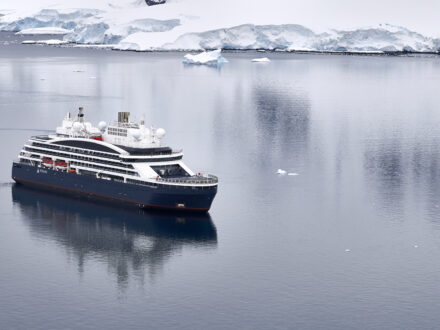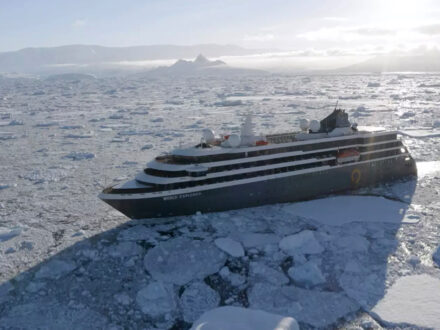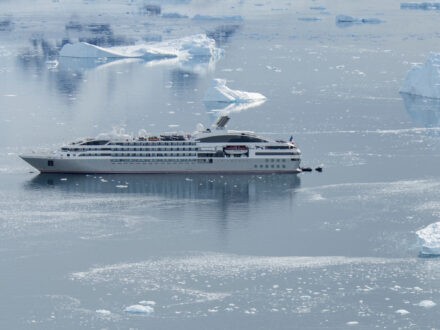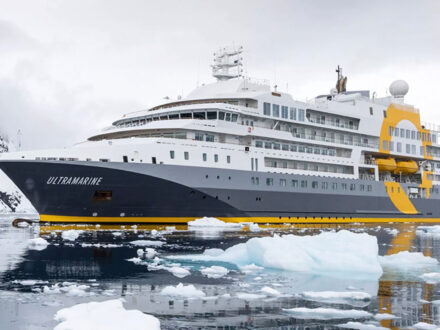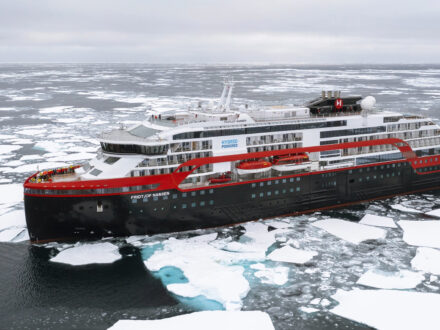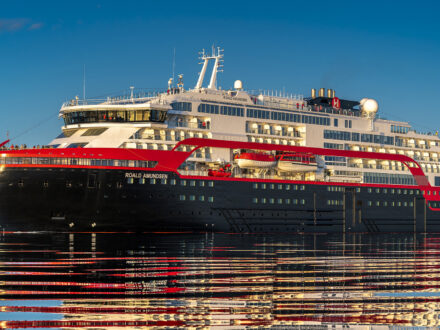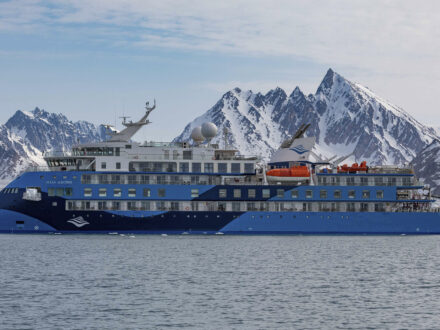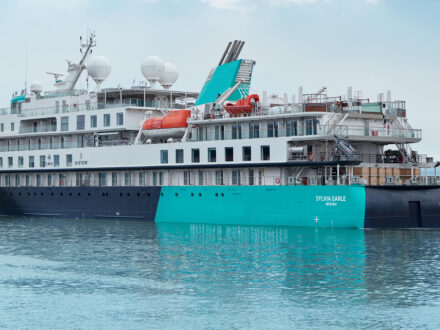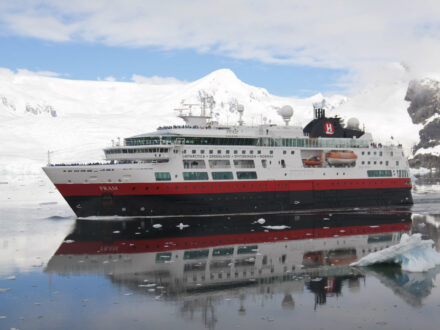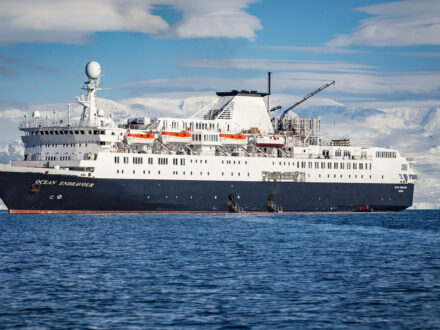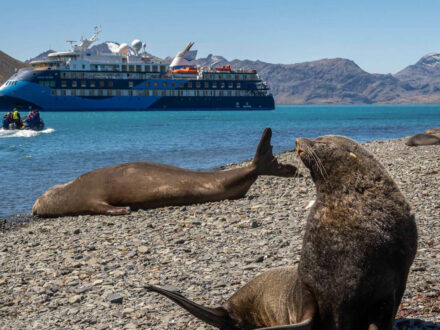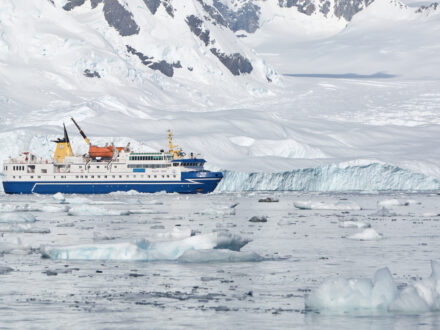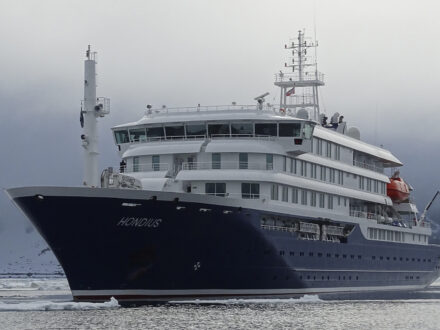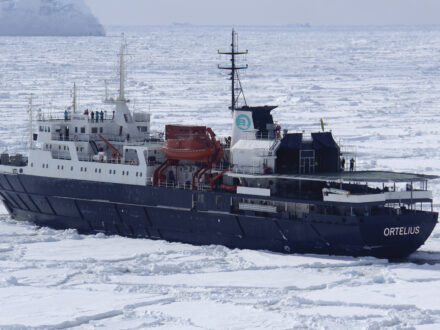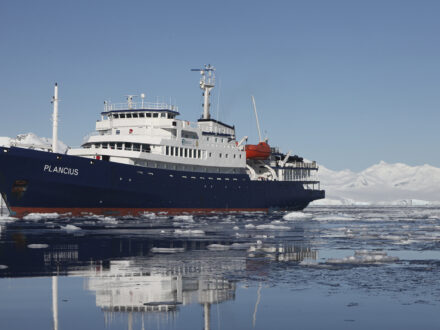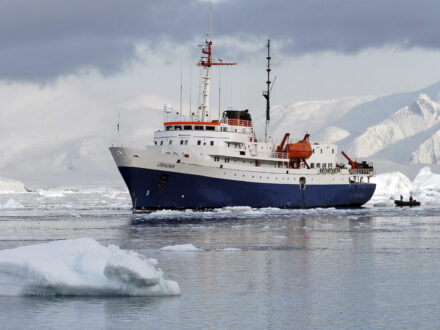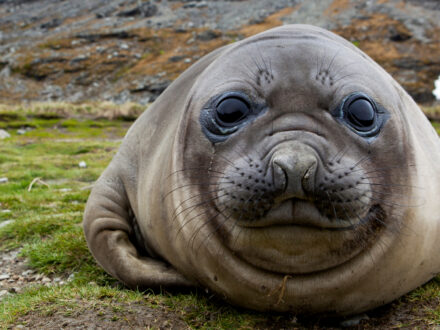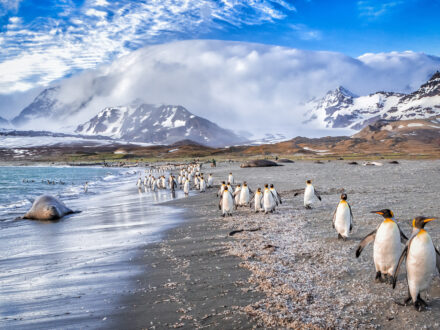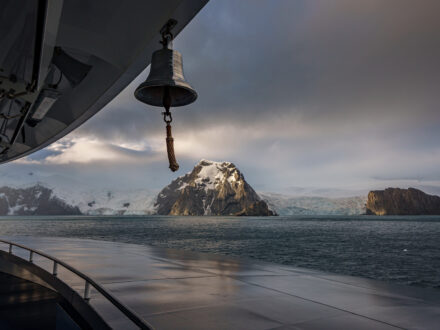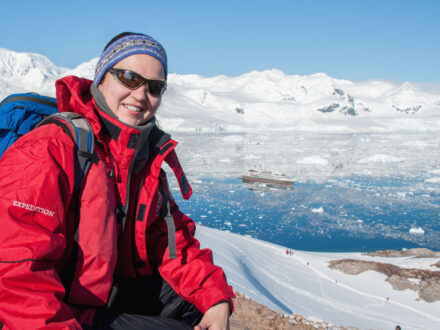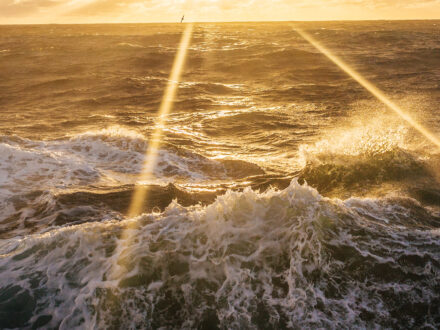Antarctica Cruise Ships: Which Expedition Vessel Is Best?
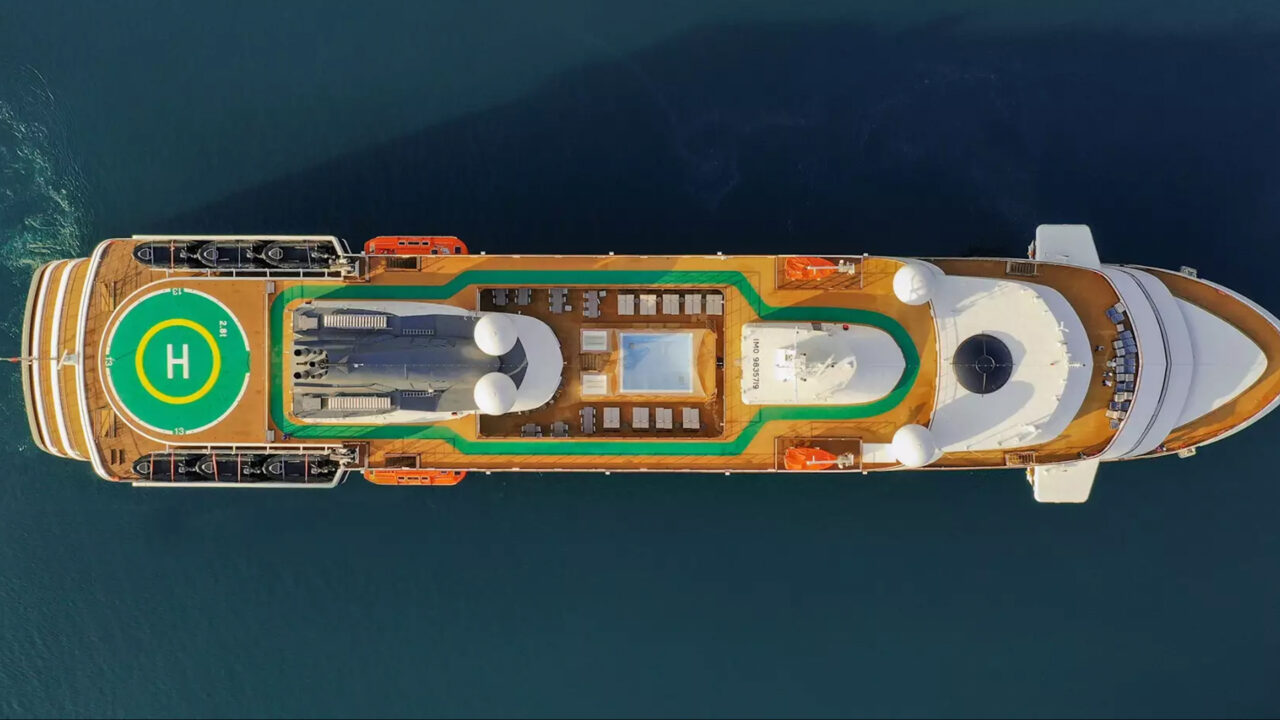
- Antarctica Cruise Ships: Then & Now
- What Makes A Good Expedition Vessel?
- Small Size
- Stability
- Observation Decks and Facilities
- Ice-Strengthened
- Responsible & Safe
- Experienced Captain & Expert Crew
- Does It Really Matter Which Antarctic Ship I Go On?
- The Best Antarctica Cruise Ship … For You?
- Antarctica Cruise Ship Categories
- The Best Expedition Vessels
There are now over 70 Antarctica cruise ships sailing across the Southern Ocean to the wondrous White Continent, a number that has been steadily increasing each year due to the gaining popularity of expedition cruising. With so many options to choose from, selecting the best expedition vessel for you can be a daunting prospect.
Ships can range anywhere in size from tiny sailing yachts with fewer than 25 guests to traditional ocean liners with over 1000 guests, but crucially those Antarctic ships with more than 500 guests onboard are not permitted to make landings with guests unable to set foot on Antarctica itself, merely allowing them to see the continent and wildlife from afar.
Here at Antarctica Cruises we exclusively offer true expedition vessels, small Antarctica cruise ships for 50–500 guests, large enough to safely and comfortably cope with the icy and adverse sailing conditions prevalent at higher latitudes, yet small and nimble enough to navigate icebergs and access Antarctica’s remotest reaches, facilitating extraordinary, close-up wildlife encounters and providing passengers with a privileged view of the most breathtaking wilderness on the planet.
Antarctica Cruise Ships: Then & Now
But before we look at the latest fleet of expedition vessels, it’s important to understand their evolution. Until 1892—when the Fram was constructed explicitly for polar exploration—all ships had been built for some other purpose, namely naval (Terror & Erebus), sealing (Nimrod, Aurora & Belgica), or whaling (Terra Nova) purposes, and were only used in the polar regions as a consequence of their stronger than usual design features making them suitable for icy seas. Cook’s Resolution—the first vessel to cross the Antarctic Circle back in 1773—was another prime example, formerly being a sturdy North Sea merchant collier named the Marquis of Granby.
Ship’s bell is still present on all ships as required by maritime law
Often enhancements were made though, their original wooden hulls often reinforced for polar conditions, ice anchors added for mooring on the ice, as well as installing specialized equipment for navigation and conducting scientific research. This pattern of repurposing and revamping vessels has continued into the modern expedition era. Even the first tourist Antarctica cruise ship, the Lapataia, which sailed to the Antarctic Peninsula in 1966, was an Argentinean Navy supply ship chartered by Lars-Eric Lindblad, and many of the more authentic expedition vessels still in use today are tough-built government or scientific ships, often old ex-Soviet polar research vessels, designed with navigating icy areas but not necessarily comfort in mind.
However, with tourist expectations evolving, the latest fleet of expedition vessels are a new breed of boat entirely, not only purpose-built for polar voyages, but also catering to the discerning traveler. The poles were previously the sole province of explorers and scientists, and as such their ships were more utilitarian in nature, foregoing comfort for functionality, but these days Antarctica is a mecca for intrepid travelers and modern-day ships are designed explicitly for adventure travel with ample amenities and creature comforts befitting their new clientele.
Rowboats have been replaced by rigid inflatable boats (RIBs), glowing candles by glittering chandeliers, ice anchors by GPS-driven dynamic positional systems. Barrels of porter and potent primus stove-cooked grog concoctions have become tended bars with a choice of cocktails, rations replaced by refined epicurean dishes, snow melt baths substituted for saunas and steam rooms, the graph paper and gramophones long gone, their place taken by powerpoint presentations and lecture theaters. Crews have also evolved, from seamen and scientists, to seamen and scientists turning their hand to hospitality, and now professionals with responsibilities solely aligned to their specialisms, including dedicated customer service staff.
Propulsion-wise, wooden sailing boats, subservient to the Southern Ocean’s winds, ice and currents—and often prone to being iced in—were slowly replaced by more powerful steam-powered ships with screw propellers, capable of entering, maneuvering (reversing) in, and gradually ramming through pack ice. Such slow progress was very heavy on coal, so for many years Antarctic vessels were hybrids of wind and steam power, the former used whenever possible to conserve coal stocks for when the going got tougher.
Later, the advent of steel hulls for extra strength and more powerful engines—typically run on Diesel, Marine Gas Oil (MGO) or Marine Diesel Oil (MDO)—meant ships went from weighing less than 400 tons to 20,000 tonnes or more, and having engine power of just 20hp to over 20,000hp in less than a century. The most modern vessels are now being run on a cleaner combination of liquified natural gas and electricity.
What Makes A Good Expedition Vessel?
The ideal characteristics (and, in many cases, requirements) for historical Antarctic expedition ships were primarily related to their hull, needing a strong, rounded hull—to both minimize ice damage and help the ship slide upwards rather than being crushed by pincering pack ice—complete with a reinforced, skewed bow to not only withstand head-on ice impact, but also ride up and over it, causing it to break under its own weight.
South Pole style ice breaking
Given historic vessels often over-wintered in Antarctica, they additionally needed to be well insulated to retain heat and have plentiful stowage space for both scientific equipment and food, typically with provisions for at least a year longer than the intended voyage in case the ship became iced in. Entertainment to pass the long, dark winter months was essential for crew contentment, and a powerful engine, economical with scant coal reserves, a priority for working in the heavy ice conditions of winter, not to mention a selection of ice saws and some dynamite to help break a passage to open water come spring.
Whilst modern expedition ships only visit Antarctica in the austral summer, hull design and fuel economy are still high on the agenda, with today’s technological advances leading many of the newer Antarctica cruise ships to now use an ‘inverted’ X-Bow design to improve handling in rough seas and reduce hydrodynamic drag to lower fuel consumption. In contrast, these days the scientific equipment on board very much forms part of the entertainment for latter-day explorers, their explosive ecological revelations thankfully replacing any TNT.
Let’s take a closer look at what else constitutes the perfect polar expedition cruise vessel for exploring the White Continent.
Small Size
Expedition vessels are considerably smaller than your typical ocean liner or river cruise ship, for several reasons. Firstly, they allow access to areas larger ships simply cannot go, their sleek design, slighter tonnage, and shallower drafts (the amount of ship below the water level) making them more agile to respond to opportune whale or dolphin sightings, and better able to maneuver into those shallow harbors and remote coves and bays along Antarctica’s coastline where these the most pristine landscapes, penguin rookeries, and seal colonies often prevail.
Not only are Antarctic expedition cruise ships small in size, but they also host fewer passengers, engendering a genuine feeling of camaraderie and promoting a convivial atmosphere on board with your fellow passengers and crew alike. Indeed on many of the smaller ships guests even assemble as a single group for communal meals. What’s more, expedition ships often have much higher crew-to-guest ratios than their ocean-going counterparts, leading to a higher level of customer service.
Antarctic expedition ship capacities range from just 13 to a maximum 500 guests, with an average of a little more than 100. Ships can be technically classified according to their capacity, with ‘Category 2’ ships those hosting between 201-500 passengers aboard, and ‘Category 1’ ships host just 13-200 passengers. (There is a third ‘Cruise Only’ classification for ships catering to 501+ passengers, but it is important to realize that these vessels are not permitted to make any shore landings in Antarctica so these are not expedition cruises at all, and are very much considered sight-seeing cruises from a distance.)
The closeness to nature (and your few fellow explorers) from a smaller expedition vessel makes for a much more intimate and rewarding expedition experience, affording prolific and personal wildlife encounters, and enhancing the sense of wilderness and solitude in the vast polar landscape. When you combine this close proximity with the fact that shore landing logistics are significantly swifter and easier with smaller groups, this helps to maximize your time ashore—particularly pertinent in Antarctica where only 100 people are permitted to land at any one time—and grants a greater chance of participating in any optional adventure activities, in depth, for longer.
But perhaps most important of all, small Antarctica cruise ship size is crucial in minimizing the impact on the delicate ecosystems you are visiting by reducing carbon footprints and footfall ashore.
Stability
Whilst around 10% of the overall population are more susceptible to sea sickness than others, everyone has the potential to experience it—especially if you are crossing the Drake Passage! Caused by a conflict between what you see and what your body feels (specifically your inner ear, where the human balance mechanism resides) this can be mitigated, or eliminated altogether, by being aboard a more stable boat.
So which ships are the most steadfast, resolute and unwavering in the face of the unfathomable waves and implacable winds of the Southern Ocean? Whilst smaller ships may be more agile, generally speaking it’s the larger Antarctica cruise ships that will provide greater stability. However, it is also worth noting that many smaller expedition vessels may be equally equable if equipped with stabilizers.
There are several types of stabilizer, each with varying degrees of effectiveness, correlated to the degree of lateral roll (the disorienting side-to-side motion common in rough sea conditions) experienced by the ship. Traditional ship stabilizers, also known as bilge keels, are long strips of metal attached to the outer hull of the ship just below the water line. These add physical resistance in turbulent waters to counter any rolling pressure.
Fixed stabilizers akin to fins situated on both sides of the ship at both the bow and stern are slightly more effective, protruding further than bilge keels and providing more resistance to rolling. However there are several downsides to such fin-style stabilizers, as they prove ineffective when at anchor (they rely on the forward speed of the ship to generate the roll stabilizing moment), reduce maneuverability, and require greater clearance when docking.
In contrast, the latest, state-of-the-art gyroscopic stabilizers found on modern expedition vessels use a sensor detecting system to automatically adjust fin stabilizers to exert the appropriate pressure to counteract movement according to prevailing sea and wind conditions, and can even fully retract them into the hull of the ship to enable precision docking. These can effectively reduce lateral roll by up to 90%, even when at anchor. Music to the (inner) ears of those concerned about sea sickness!
Modern boats with modern solutions
Be warned that whilst such stabilizers greatly reduce ships rolling, they won’t assist with pitching (the front to back movement of a ship). For this reason, many of the more modern polar expedition cruise ships, especially those that cross rugged sections of ocean, have a longer and narrower bow to cut through the waves.
Whilst the stability of the vessel itself is a major consideration for those susceptible to sea sickness, there’s also the question of the stability of the smaller boats used for shore excursions and wildlife spotting cruises around the iceberg-strewn shorelines. The majority of operators use military-style Zodiac boats (rigid-hulled inflatable boats similar to those famously used by Jacques Cousteau), but a few have begun using Norwegian-made Polarcirkel boats instead—named so after the Norwegian for ‘Arctic Circle’—which some argue are better for less sure-footed seniors as they are easier to get on and off of and supposedly provide a smoother ride experience.
Observation Decks and Facilities
Incredibly, wildlife watching was even an important consideration in early expedition vessel design. Cook’s Resolution, for example, was originally modified to incorporate a heightened waist, additional upper deck, and raised poop deck for better viewing at the request of naturalist Joseph Banks who was supposed to be part of his expedition team, but unfortunately in sea trials the ship was found to be too top-heavy so these had to be removed and Banks subsequently didn’t join.
The closest contemporary comparison to this are the vast, wrap-around observation decks found on nearly all present-day polar ships, allowing passengers unrestricted views of the stunning ice-laden land- and sea-scapes and their fascinating faunal entourage. Even when below deck, either inside panoramic lounges with floor-to-ceiling windows, or even from the comforts of your cabin or balcony, many vessels these days afford privileged viewing opportunities from every conceivable vantage point. Some of the latest vessels even have hydraulic viewing platforms that extend out and over the sea and ice during navigation, and better yet, some have helicopters for astonishing bird’s-eye views.
Thanks to recent technological advances, wildlife observation for tourists isn’t just restricted to above the water line any more. For those seeking subaqueous observational opportunities, some ships come with underwater video cameras, remotely operated vehicles, or indeed their very own small submersibles that will take you deep into the icy Antarctic waters to see an underwater world that so few have seen that they say more men have gone to the Moon!
Lounges with panoramic windows are always a popular spot on board
Ice-Strengthened
Ice-related ship damage in the polar regions poses a real threat, the dangers of being holed and sunk, or nipped (trapped in a vice-like grip) and forced to drift for hundreds or thousands of miles over many months a distinct possibility—as the 1915 sinking of Shackleton’s ill-fated Endurance is testament to after it was beset in pack ice for 10 months before being crushed between enormous ice floes, as is the Brazilian Research Vessel Mar Sem Fim—better known as the Antarctic Ghost Ship—which suffered a similar fate as recently as 2012.
As such, the ability to safely navigate through potentially hazardous, ice-infested polar waters has always been, and remains to be, a critical design consideration of all Antarctica cruise ships. To thwart such possible piercings and pressures, polar expedition vessels are ‘‘ice-strengthened’, their hulls made hardier to withstand such sudden or significant loads. (Should a ship’s heft and power be sufficient to push their way through the most solid continuous ice as well, they are additionally given the moniker of “Icebreaker”.)
The level of ice-strengthening a ship has undergone dictates its Ice Class. Ice classes have been around for the best part of a century, first evolving in response to Baltic, and later Arctic, sea conditions, before being more widely adopted in Antarctica. Various governments and classification societies have created their own ice class rules over the years—the Swedish-Finnish Ice Class Rules, DNV GL, American Bureau and Lloyd’s Register of Shipping to name a few—each with their own unique approach, requirements, and class notation.
Sea ice in the Southern Ocean
To the considerable confusion of travelers, this means that depending on a ship’s registering authority, they may use a completely different classification system to other ships sailing the very same route, making it difficult to assess their differences. Whilst many have tried to ascertain the equivalencies of these various ice classes, it wasn’t until Unified Requirements for Polar Class Ships (structural and mechanical stipulations)—better known the Polar Class rules—were published in 2007 by the International Association of Classification Societies (IACS) that a consolidated universal approach and notation was defined, ranging from PC 1 (highest) to PC 7 (lowest), with each level corresponding to operational capability and strength of the vessel. However, you may still see some ships using legacy alphabetical ice class notations such as 1AS, 1A-1D as the Polar Class rules are only applicable to vessels constructed after 1 July 2007, with 1AS (i.e. 1A Super, ~ PC 6) being the highest, followed by 1A (~ PC 7), and so on.
Specific to Antarctica expedition ships, numerous ships have been built to the two lowest polar classes PC 6 (summer/autumn operation in medium first-year ice which may include old ice inclusions) and PC 7 (summer/autumn operation in thin first-year ice which may include old ice inclusions), but only a small number of ships such as National Geographic Endurance have been assigned polar class PC 5 (year-round operation in medium first-year ice which may include old ice inclusions).
Responsible & Safe
When venturing to such a wild and remote realm as Antarctica, where ice conditions impose extreme loads on ship hulls and propulsion systems, and rescue (and clean up) operations face significant obstacles and costs, it’s paramount to travel with polar operators with requisite experience that adhere to stringent safety regulations and who operate in a sustainable and responsible manner, not just for your own safety but also that of the wildlife and the delicate ecosystems of this pristine continent. Here at Antarctica Cruises we only work with vessels that are Polar Ship Certified by the International Maritime Organization (IMO) and whose operators are members of the International Association of Antarctica Tour Operators (IAATO).
Since 2017, the IMO’s International Code for Ships Operating in Polar Waters—better known as the Polar Code—has been mandatory for all ships operating in the Arctic and Antarctica. This Code addresses the unique risks present in polar waters, going above and beyond the IMO’s existing international conventions for the Safety of Life at Sea (SOLAS) and for the Prevention of Pollution from Ships (MARPOL) that apply to all ocean-going vessels. Its comprehensive measures require ships to be assessed and polar ship certified, and covers everything from design and construction specifications, to equipment and training requirements, search and rescue procedures, and pollution prevention.
Formed in 1991, IAATO is a voluntary organization of private-sector companies that advocate for safe and environmentally responsible travel to Antarctica. Operating within the framework and under the authority of the Antarctic Treaty System, including both the Antarctic Treaty itself and Antarctic Environmental Protocol, its members put their competitive differences aside to engage their respective governments, collaborate, and establish substantive operational procedures and guidelines for all to follow.
Members vow to follow strict protocols to visit Antarctica safely and responsibly, with minimal impact on the natural environment, demonstrating a commitment to approach and keep a safe distance from wildlife, dispose of waste materials properly, and have adequate insurance, experience, and contingency plans in place to anticipate and respond to any potential emergency situations.
Safe passage through the ice
Experienced Captain & Expert Crew
As part of these protocols, IAATO members also subscribe to adhering to proper levels of staffing, not just in terms of sufficient numbers—a minimum expedition passenger-to-guide ratio of 20:1 ashore applies—but also requisite qualifications and relevant experience. For example, all field staff must pass an IAATO online assessment module, and 80% must have previous relevant experience, with 50% specifically in Antarctica.
These strict staffing stipulations are particularly pertinent up on the bridge. Expedition vessels sailing south of 60°S latitude must have a Captain (or appointed Ice Pilot) and Bridge Officers with ample Antarctic experience who know how to safely navigate ice-choked channels, big ocean crossings, and precarious shore landings, putting the safety of the ship and passengers above all else, at all times.
Despite all cruise ships to Antarctica satisfying such requirements, bear in mind that the caliber and size of the expedition team can still vary significantly between ships, with some offering much lower passenger-to-guide ratios for landings (anywhere from 20:1 to 6:1) and passenger-to-crew ratios aboard (anywhere from 5.5:1 to 1.2:1) than others. Whilst a vessel and its amenities are undoubtedly a large factor in assessing whether an Antarctica boat is better than another, its crew play arguably an even more pivotal role in the polar expedition experience you desire.
Behind the scenes, even before you embark your cruise, their polar prowess is crucial in carefully coordinating and skillfully crafting your itinerary in advance. And when you are cruising, they’ll be dictating service levels and atmosphere aboard with their professionalism and personality, and enriching your voyage with their expertise and knowledge during entertaining lectures and on excursion.
Does It Really Matter Which Antarctic Ship I Go On?
Regardless of their age, size, design, capacity or cost, all our Antarctic expedition vessels abide by the Polar Code, are IAATO members, and have one thing in common: they represent the spirit of adventure and exploration that has driven humans for centuries to brave the elemental forces of the Southern Ocean in search of the natural riches of this mysterious Terra Australis Incognita—the scientific heritage and passion for natural history of the great early explorers still very much alive and visible in the on board educational programs at the heart of all expeditions.
But that doesn’t infer you’ll have the same expedition experience aboard any Antarctica cruise ship by any means. Indeed, your choice of Antarctica expedition ship can have a big impact on your overall travel experience. Each ship offers its own advantages, from unique amenities and adventure activity options, to different on board atmospheres and dining experiences, not to mention the contrasting personalities, experience and specializations of their respective crews. Some may have more Zodiacs—and more importantly, loading bays—than others, making for faster disembarkation to get you out on excursion that much swifter.
Despite the allure of the adventures that await you off-ship, it’s worth remembering that a significant portion of your cruise will be spent on board your chosen expedition vessel. This means that choosing the right Antarctica cruise ship and getting the right experience that suits you personally will be one of the most important decisions you make.
The Best Antarctica Cruise Ship … For You?
We know how crucial finding the right ship is, but with so much choice it can be bewildering to any prospective polar explorer. Our first hand knowledge of Antarctic cruise ships is unparalleled and we can help you ascertain the critical criteria that matter most to you, curate a shortlist of suitable ships, or recommend the ideal vessel.
A great first step is asking yourself what your key decision-making criteria are. Are you a fitness fanatic, glutton for gastronomy, or adventure aficionado? A sybarite seeking extravagance, or sociable sort in search of a convivial atmosphere? Perhaps you’re prone to seasickness and need something more stable, or partial to some privacy and simply must have your own balcony? What if you’re traveling with family or friends and want a larger suite or interconnected cabins? Answering these kinds of questions will help you whittle down your ship shortlist in no time.
If you’re in search of more active exploration, camping out on the ice and kayaking are offered on most vessels as optional extras but much sought after and availability can be limited. Should you want to try something even more adventurous like diving, snorkeling, paddle-boarding, snowshoeing, mountaineering or more, your ship selection soon narrows as seldom few offer these.
Smaller ships of fewer than 100 passengers have considerable benefits, not least ease of logistics for shore excursions with everybody being able to land at once, and a more intimate overall experience. However these can be counterbalanced, or sometimes outweighed, by the wider range of amenities, cabin types and greater stability afforded by larger vessels.
Antarctica Cruise Ship Categories
Whether you want a smaller ship for a more intimate and authentic expedition, a budget-conscious boat option, or a larger, luxurious ship with unsurpassed levels of comfort, Antarctica Cruises is proud to offer a wide portfolio of polar class vessels to quench every type of traveler’s thirst for adventure, no matter their budget.
Whilst undoubtedly each of these Antarctica ships have their own unique atmosphere, amenities and advantages, to help make the choice a little easier we’ve organized them into three main categories: Authentic — small, simple and safe ships for the pure polar experience; Mid-Range — slightly larger ships with upscale accommodations and upgraded amenities; Luxury — larger, more modern ships with world-class amenities, ambiance and service.
Authentic Expedition Ships
Whilst some ships show off their often superfluous amenities and services—from massage therapists and hot tubs, to boutiques and beauty salons—others offer a more simplistic, no frills approach with a focus on the experience off-ship over style on it, which helps to keep costs down and is ideal for the more budget-conscious explorer content with being in, and beholding the beauty of, their spectacular surrounds with like-minded travelers.
A number of ships in this category are former working ships or ex-research vessels, purposefully designed for, and well-versed in, polar navigation, steeped in maritime heritage and expeditionary heart, and providing a safe and functional foundation for exploration. What they may lack in panache versus more premium options, they gain in a sense of adventure and authenticity, representing for many the true spirit of a traditional expedition voyage with their comfortable but modest bunk cabins, porthole windows, and convivial refectory meals.
Despite their more economical price point, many people believe they give you a better Antarctica experience as they tend to have more deck space for greater viewing opportunities, and are generally smaller in size and capacity (just 50–175 passengers), offering not only greater access to the region’s remotest reaches, but also a more intimate atmosphere both on board and on excursion, giving you more opportunities to participate in landings and adventure activities, and increasing the chances of close, unforgettable wildlife encounters.
Hondius (174 Passengers)
Ocean Nova (75 Passengers)
Plancius (108 Passengers)
Ortelius (108 Passengers)
Ushuaia (90 Passengers)
Expedition (134 Passengers)
Spirit of Enderby (50 Passengers)
Janssonius (174 Passengers)
Shokalskiy (50 Passengers)
Hondius
Mid-Range Expedition Ships
Often prospective Antarctica cruise-goers fall in love with the romance of intrepid exploration like that of the Heroic Age, but secretly yearn for soothing spa treatments and indulgent fine dining—no surprise then, that the multitude of modern, medium-sized (75–200 passengers) expedition ships available in this category entice many with their allure of comfortable adventure.
Superior to authentic expedition ships with their upgraded facilities and suite-style cabins, these mid-range vessels are more floating four-star hotels than cruise ships. Although not as luxurious or well-appointed as those in the luxury category, they still pack a punch when it comes to perks, often providing full media lecture rooms and wellness centers, fully stocked libraries and bars, generous deck space and public areas, as well as a wider array of activity options such as kayaking and camping to partake in.
Whilst none of these expedition ships can be truly called luxurious, many consider them the perfect compromise between the smaller authentic ships and larger luxury vessels—still small enough for optimal landing logistics and an amiable ambiance, but with the added benefits of bigger accommodations and better amenities—and the Antarctic experiences they offer are prestigious in their own right thanks to the enriching knowledge and geniality of their high caliber and highly experienced expedition teams, some of whom have been working in Antarctica for a quarter of a century.
Ocean Explorer (140 Passengers)
Ocean Victory (189 Passengers)
Ocean Albatros (169 Passengers)
Greg Mortimer (120 Passengers)
Magellan Explorer (73 Passengers)
Heritage Adventurer (140 Passengers)
Sylvia Earle (120 Passengers)
Douglas Mawson (154 Passengers)
Fram (200 Passengers)
Sea Spirit (100 Passengers)
Seaventure (139 Passengers)
National Geographic Endurance (138 Passengers)
National Geographic Explorer (148 Passengers)
National Geographic Orion (102 Passengers)
World Explorer (176 Passengers)
Ocean Endeavour preparing for an excursion
Luxury Expedition Ships
For those keen to live the high latitude high life, seeking to immerse themselves in the expedition experience as well as receive the white glove treatment on the White Continent, these premier polar vessels provide a level of opulence and delights that are best described as world class. Akin to super yachts with their magnificent staterooms, outstanding amenities, ambiance and service, not to mention epicurean cuisine, elegant décor and luxuriant and spacious social areas, these truly are a breed of boat apart.
These are the newest cruise ships to sail to Antarctica, a new wave of larger (140–500 passengers), purpose-built vessels boasting unparalleled comfort and all the latest in technological advances, from state-of-the-art recreational toys and scientific gadgets, to much more fuel efficient and eco-friendly propulsion than their older counterparts, so the premium price you pay for this privilege not only brings you extra benefits but also means the Antarctic environment pays less.
You can expect all the grandeur of a luxury hotel in terms of facilities, with five-star amenities from fitness centers, spas and Jacuzzis, to a choice of restaurant options and oversized sun-decks. There will be more people on board though and you will need to take into account that only 100 people can be ashore at one time, so be wary you may be limited to just one excursion each day. Luxury Antarctica ships undoubtedly offer an extraordinary means of exploration, but they are the most expensive as a result.
Ultramarine (200 Passengers)
Fridtjof Nansen (500 Passengers)
Roald Amundsen (500 Passengers)
Silver Explorer (144 Passengers)
Silver Cloud (240 Passengers)
Silver Wind (240 Passengers)
Le Lyrial (244 Passengers)
Le Boréal (264 Passengers)
L’Austral (264 Passengers)
Le Soléal (264 Passengers)
Le Lapérouse (184 Passengers)
Le Commandant Charcot (245 Passengers)
National Geographic Resolution (138 Passengers)
Zodiak expedition with World Explorer
The Best Expedition Vessels
Still not sure which ship to select? Antarctica Cruises have compiled a list of the best expedition vessels for you to choose from, each and every one providing an immersive, inspiring and profoundly rewarding adventure of prodigious proportions, a voyage to an otherworldly and pristine far-off frontier through unbridled nature and time itself, following in the very wake of the world’s most renowned Antarctic explorers.
Disclaimer
Our travel guides are for informational purposes only. While we aim to provide accurate and up-to-date information, Antarctica Cruises makes no representations as to the accuracy or completeness of any information in our guides or found by following any link on this site.
Antarctica Cruises cannot and will not accept responsibility for any omissions or inaccuracies, or for any consequences arising therefrom, including any losses, injuries, or damages resulting from the display or use of this information.










































